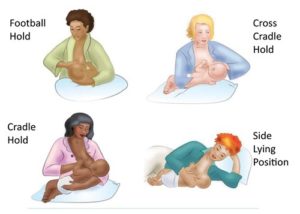 Every mother wants the best for their baby. Breastfeeding can promote mother-child relationship through touch, improve the immune system and the antibodies to prevent infection to the baby, shrink the mother’s uterus as well as supply much-needed nutrients in the early phases of growth and development of the babies.
Every mother wants the best for their baby. Breastfeeding can promote mother-child relationship through touch, improve the immune system and the antibodies to prevent infection to the baby, shrink the mother’s uterus as well as supply much-needed nutrients in the early phases of growth and development of the babies.
Below are some of the tips, advice and the advantages of breastfeeding from a nurse’s perspective. This article was written specifically for mothers who are waiting to give birth (irrespective of whether it is their first or subsequent experience), fathers who are always eager to understand how to care for the little ones, women who want to enhance understanding of baby care in terms of breastfeeding, nurse-to-be, or those who are currently working (and learning) or used to work in any maternal and child health institution in Malaysia.
Ensure the mother is comfortable
To start breastfeeding, the mother should be concerned with the principles of body mechanics. What is body mechanics? Body mechanics is an adaptive body coordination system to avoid injury to our own body. To simplify it, body mechanics is in place to avoid our body from quickly tiring or feeling sick.
First, the mother should recline on a chair/wall/bed headrest with something soft lining those such as a pillow or a thick cloth. She should be sitting upright, not in a bent or bowed position. This is to ensure that the condition of the spine (spinal alignment) is in an upright position and not depressed. Lying on a pillow or soft objects can reduce aches and pains at the back of a body. When breastfeeding, do not try to move the mother’s body closer to the baby, instead, practice techniques of bringing the baby closer towards the mother’s body. This is to prevent a mother’s sitting position in a bent position as a result of an attempt to deliver their nipple towards the baby’s mouth.
Although it has been a common practice for the mother to breastfeed while lying down (e.g. while watching television or relaxing), do not attempt to breastfeed while lying down. This can prevent aspiration (entry of liquid into the lungs) and also suppress the respiratory cavity (with breast) to the baby. There are many cases of drowned or choked babies during breastfeeding where the mother accidentally fell asleep. (Info: A mother’s breasts become larger and heavier when full with milk). This same situation occurs when we feed formula milk to the babies in a lying down position. An infant swallowing reflex is unable to control the milk ingested, hence, the milk will continue to flow into the respiratory tract. Coupled with a situation whereby an infant who is unable to regurgitate milk (by coughing), this will increase the risk of aspiration and subsequently caused them, breathing problems.

Picture source: Algoma Public Health
Breastfeeding positions
There are three breastfeeding positions that are popular among breastfeeding mothers Each technique and position are concerned for the baby’s safety and position, the comfort of the mother and the usage of both breasts.
‘Cradle hold’
This is one of the most classic and most frequently used positions by the mothers. The trick is to support the baby’s head between the folds (elbows) of a mother’s hands, his/her back is supported by the mother’s palm, and the baby’s abdomen is positioned close to the mother’s body. Keep the baby in an upright or slightly diagonal inward position, towards the mother’s abdomen. This technique is often practised using both sides of the mother’s hand as additional support. Ensure that the seat occupied by the mother has a place to rest her arms in ensuring that her arms will not be easily tired. If the mother wants to breastfeed using her right breast, she needs to hold the baby using her right hand. This technique is suitable for babies who are able to control their neck, and mothers who delivered babies via vaginal delivery (normal). However, this position is not suitable for women who underwent caesarean section (to avoid pressure on the surgical wound).
‘Cross-cradle hold’
This technique is also similar to the ‘cradle hold’ technique, except the other arm is used in this technique. If a mother wants to breastfeed using the right breast, the mother should use her left hand to hold the baby. The trick is to hold the baby’s head with the palms of the mother’s hands, with her forearm supporting the baby’s spine, and the folding (elbow) mother’s arm supports the baby’s buttock. The positions of the mother’s thumb and her index finger are placed behind the baby’s ears as additional support and to control the direction of the baby’s mouth (towards the nipple). This technique is suitable for infants who are not well versed/ experience problems latching the areola (the nipple) mother.
‘Football hold’
As the name suggests, the baby is held as if the mother is holding/hugging a rugby ball (or a purse). If the mother wants to breastfeed using her right breast, she should use her right arm. Position the baby in a lying position in which the baby is placed under the mother’s arms (armpit), with the baby’s nose facing the mother’s nipple. The baby’s foot is reclined towards the mother’s back. Hold the baby’s head, neck and shoulders with the mother’s right palm on the head. The mother’s arm is used to support the baby’s body, hence, the arm should be placed on a pillow. Use the other free hand (the left hand) to direct the nipple and move the baby toward the nipple. This technique is suitable for women who gave birth by Caesarean section (to avoid pressure on the wound), and mothers with twins. Practice this technique using pillows, prior to holding the baby to prevent the baby from falling and improve the baby-handling skill for new mothers.
In any selection of the breastfeeding position, make sure that both breasts are used during one feeding session. Encourage breastfeeding by switching the breast in order to avoid the accumulation of milk in one breast and ‘engorgement’ (swelling due to milk).
Feeding time
Breastfeeding your baby based on the exclusive and ‘on demand’ principle, i.e. breastfeeding/suckling is done when the baby wants milk or when the mother experiences discomfort in the breasts. In simple words, every time the baby made a ‘demand’, breastfeed exclusively, irrespective of the time. If you are working/not with the baby, perform milking periodically. The on demand principle can help mothers in preventing complications such as breast engorgement (certain breast area is hardened and painful), reduction of milk production and this may eventually lead to mastitis (inflammation of the breast tissue).
Breastfeeding techniques
When breastfeeding, encourage stimulation of the baby’s mouth. For starters, move your little finger in the baby’s mouth or in the area between the chin and the baby’s mouth. This is to give a signal to the baby to open his/her mouth to start latching and encourage sucking. This technique is known as ‘rooting reflex’, where the baby is given a boost to direct his face (mouth) towards a given stimulus (finger).
Ensure the baby’s mouth covers the entire areola (the area around the nipple) before feeding begins (latching). If latching is performed improperly (e.g. only on the nipple), this will cause injury to the nipple when the baby starts sucking. This will cause pain to the mother when breastfeeding. If latching covers the entire areola and is complete, feeding can begin and the baby will end up, sucking nothing. If the latching is incomplete, it is recommended to stop breastfeeding, remove the baby’s mouth and perform latching all over till it becomes complete.
Stop breastfeeding only when the baby unlatches, without any coercion by the mother. Never pull/snap/force the baby to stop breastfeeding when suckling and latching are still ongoing. This is to prevent wound to the nipples (sore nipples), prevent infection (from injury) and to prevent the breastfeeding routine (due to pain from a wound). If you want to stop breastfeeding to switch to another breast or start a new latching, insert your little finger into the baby’s mouth slowly from the side of the mouth, put the finger inside till you hear the sound of ‘pop’ (slow sound) or until the baby unlatches. This method is carried out in ensuring that the baby does not pull the nipple and cause a wound. If the mother does not want to use a finger, practice pulling the baby’s chin gently till he/she opens his/her mouth and unlatches.
The breastfeeding period
Breastfeed from birth till the baby reaches 6 months old. Do not give any additional food/formula milk when the baby has not reach the age of 6 months. This is because breast milk is the best in forming the infant’s antibodies and immune system during the early stages. Breastfeeding also helps in shrinking the mother’s uterus after childbirth. This can assist the mother undergoing the confinement period. Any food or formula milk is prohibited at this point. At this stage (6 months and below), the baby’s digestive system is still not well developed and has not reached the stage of maturity.
Once your baby is 6 months or older, continue breastfeeding. At this point, food can be given, however, it is encouraged that food to be given in stages. Do not feed the baby with food that is difficult to digest, chew or solid food (hard and does not crumble easily). This is to ensure that the aspiration risk can be reduced, and train the baby to start swallow solid food/milk.
Once the baby reaches the age of 2 years, breastfeeding may be continued, if any, and continue with the supplements recommended by a nutritionist or a nurse at the clinic for both the mother and the child. Each meal plan should be tailored to the infant’s nutrition depending on the growth and the development of the baby. Avoid food that provides zero nourishment to the baby during this early stage, as any food, can affect the level of nutrition, growth and development of infants.
Click this link to get tips on MOH breastfeeding recommendations (http://imgur.com/az7omOb). For complete infant nutrition tips by the Ministry of Health, click on this link (http://www.moh.gov.my/images/gallery/Garispanduan/GPBaby.pdf).
 Pacifier
Pacifier
Avoid giving pacifiers to infants at the beginning of breastfeeding. This is because it will provide a pseudo suction signal which will interfere with the breastfeeding routine. The usage of pacifiers depends on the baby’s mother. While most women prefer to use a pacifier to soothe the baby and to facilitate a mother’s movement at home/work, or as a sedative for the baby to assist the baby’s sleeping habit, the choice to use a pacifier can negatively affect the baby. The impacts are as follows: the baby’s breastfeeding routine will be interrupted causing the baby to suckle less, and even refuse to be breastfeed, and this may cause the baby to depend on the pacifier. This will complicate the process in separating the pacifier from the baby as he/she grows.
If the mother decides to give a pacifier to the baby, they are encouraged to wait until the baby reaches the age of about 3 to 4 weeks before the pacifier therapy is initiated. This is to ensure that the baby is able to differentiate breastfeeding and pacifier sucking.
For any further question or any problem, mothers are encouraged to ask the nurse in the maternal and child health clinics. I am sure that they are willing to spend their time to tell us what is important in breastfeeding, especially for new mothers.
Anwari Hamzah is a trained nurse based at a hospital in Kuala Lumpur.
[This article belongs to The Malaysian Medical Gazette. Any republication (online or offline) without written permission from The Malaysian Medical Gazette is prohibited.]
Reference:
- http://www.babycenter.com/0_positions-and-tips-for-making-breastfeeding-work_8784.bc
- http://www.parents.com/baby/breastfeeding/tips/breastfeeding-on-demand/
- https://www.medela.com/breastfeeding/advice/breastfeeding-tips/breast-engorgement
- http://www.medicinenet.com/script/main/art.asp?articlekey=5392
- http://www.livestrong.com/article/554478-how-to-get-my-baby-to-unlatch-without-hurting-me/
- http://www.moh.gov.my/images/gallery/Garispanduan/GPBaby.pdf
- http://www.mayoclinic.org/healthy-lifestyle/infant-and-toddler-health/in-depth/pacifiers/art-20048140
This article was translated by Nurul Aini Ahmad from https://www.mmgazette.com/pendidikan-penyusuan-bayi-dari-perspektif-jururawat-anwari-hamzah/
